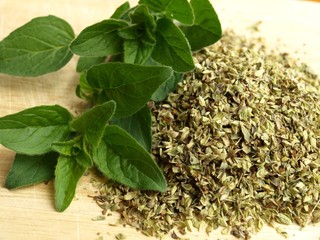Growing oregano indoors: History, uses, and best growing conditions

One of the most celebrated herbs, no one would consider their pantry complete without oregano. Generally considered an Italian herb, its applications extend far beyond pizza and spaghetti sauce. The fragrant culinary herb is part of the mint family and is sometimes called “wild marjoram.” In addition to a pungent aroma and bold, spicy flavor, the hardy perennial herb is one of the easiest to grow–as easy as chives (the ultimate beginner herb).
History of Oregano
Native to Eurasia and the Mediterranean, oregano has a long history of use in many cultures. It most likely originated in Greece, where it was believed that the goddess Aphrodite created it as a symbol of joy. The name “oregano” is derived from the Greek words oros, “mountain” and ganos, “brightness,” essentially meaning “brightness on the mountain.” It was next adopted by the Romans who spread the herb throughout Europe and Northern Africa.

Culinary Uses
Americans tend to think of oregano as the perfect partner for tomatoes, and it is, but that’s just the tip of the iceberg. Fresh oregano straight out of the herb garden makes a fantastic pesto or chimichurri sauce. Minced fine, its a tasty garnish for seafood, especially shellfish. It’s a perfect marinade ingredient for meat, and can impart rich flavor to roasted or confit vegetable. Fresh oregano will add a kick to your salads or soups and can be added to an Italian vinaigrette to drizzle over foods as well.
Bear in mind that there are subtle flavor differences amongst the many varieties of oregano (1). Mediterranean oregano (Origanum vulgare) is similar to Greek oregano (Origanum vulgare hirtum), but Mexican oregano (Lippia graveolens) is from a completely different plant family. Mexican oregano is in the verbena family, rather than the mint family, and while delicious, it enjoys hotter, drier conditions and imparts a different flavor than the Origanums. Marjoram is very closely related and the two can substitute for one another. You may want to try several different varieties to find the one that you like best. One of the best things about oregano leaves is that they retain most of their flavor when dry, so you lose nothing when preserving it by drying.

The enthusiast's guide to herbs
We’re proud to present our new e-book, The Enthusiast’s Guide to Herbs! Learn everything you need to know about growing and caring for herbs indoors, including in-depth info cards for the 35 most commonly grown herbs.
Click the link below to find out more!
Medicinal Applications
From early times, oregano was used as a medicinal herb. Ancient Greeks used it as a compress to treat sores and aching muscles, and the Chinese used it to treat diarrhea, fever, and other maladies(2). The strong flavors of the oregano plant come from carvacrol and thymol, which have antibacterial, anti-inflammatory, antioxidant properties(3) that can help fight illness. Oregano oil is commonly used as a topical antiseptic, and studies have even suggested it may fight cancer (4).

Growing Conditions
Considering that this is a Mediterranean herb named for gracing mountainsides, it’s not hard to imagine that oregano plants are hardy. This makes it well-suited to growing indoors in containers. The cardinal rule of planting oregano indoors is to give it bright light– the sunniest windowsill in the house, or even in a south-facing window box planter.
Container and Soil Type
Oregano is acclimated to drier climates, so chasing the right container and potting soil will make a difference in how well your plant performs as an indoor herb. First of all, you need to make sure that your container is an adequate size. A 6-inch pot will do, but a healthy oregano plant will quickly outgrow a pot that small. Consider a pot no smaller than eight inches, with drainage holes. Terra cotta pots with drainage trays are excellent for providing good drainage.
A cactus potting mix or a light, airy fast-draining is excellent for oregano. You can also mix your own soil using a one part potting soil to one part coarse sand or equal parts soil and decomposed granite. For extra drainage, add perlite or peat moss.
Light Requirements
Oregano likes it hot and bright, so if there is not a spot in your home that receives six hours of sun per day year-round, you may have to supplement with fluorescent light or grow light. When using artificial light, set it up so that the light is about six inches above the plant and is on a timer set to twelve hours a day, to ensure your plant gets enough light. If you’ve got a patio, you can always put your oregano plant outdoors in full sun in the summertime. However, unlike herbs indoors, you’ll want to keep a close watch to make sure there are no aphids or other pests on your plants when it’s outside.
 The biggest factor in growing healthy oregano indoors is lots of light! Whether it comes from the sun on a window sill or from artificial lights, make sure your plants get plenty of light.
The biggest factor in growing healthy oregano indoors is lots of light! Whether it comes from the sun on a window sill or from artificial lights, make sure your plants get plenty of light.
Germination and Temperature
Most folks will choose to buy an already-established plant and transplant it into a pot of their choice. You can also take cuttings from a mature plant by trimming a few stems, dipping the cut ends in rooting hormone, and planting in moist soil. This is the one time you will want to keep an oregano plant continuously moist for a few weeks until it has begun to set roots. However, if you want to plant oregano from seed, it will take a little longer but is quite simple and gives you access to more varieties.
Oregano seeds are very tiny, so then you sow them on the surface of a pot or seed tray filled with potting soil, there is no need to cover them up with soil. Just mist them with water and then cover the pot or tray with cling wrap or plastic and place the pot in a well-lit window to germinate. Within a week to ten days, you should see sprouts coming up. After a couple of weeks, pull out all but the healthiest few you want to keep.
Once your plants are several inches tall and have multiple sets of leaves, they’re ready to transplant. Take care not to damage any roots when transplanting baby plants from one pot to another. If you decide to plant oregano in a pot with other herbs, choose companion plants that have similar requirements, such as thyme, marjoram, and sage.
Basic Care
Oregano is undemanding and very drought resistant. You should only water when the soil surface is completely dry. You can fertilize occasionally, but it is generally unnecessary. If your oregano seems a little slow to put out new growth, you can treat it with a top dressing of compost, a little fish emulsion, or a dash of 10-10-10 liquid fertilizer diluted by half.
To encourage dense, bushy growth, prune your plant on a regular basis. Don’t do this to young plants until they are at least four inches tall. If you are harvesting to have fresh herbs regularly, this shouldn’t be a problem.
Harvesting and Preserving
Harvesting oregano is easy, you only have to wait until your plant is at least four inches tall. When your plant is young, you can pinch the young, green leaves, trimming off sprigs with your fingernails. As your oregano plant gets larger and woodier, you’ll probably want to use scissors to harvest stems. Whenever you pinch or cut, be sure to do it just above a leaf node to encourage growth. The more you harvest, the bushier the plant will be.

You can allow your plant to trail over the edges of its pot, or you can harvest frequently to control it. The flavor of the leaves is at its best before the plant flowers, so always try to do a big harvest when you see buds forming.
You can cut up to 2/3 of the plant at one time without causing any damage. When you do this and end up with an overabundance of fresh oregano, it’s the perfect time to save some for later by drying or using any number of less common preservation practices. To separate the leaves from the woody stems, just hold the cut end of a sprig between your fingers and using the thumb and forefinger of your other hand, strip the leaves off in one quick motion.
To learn more about drying your herbs see our full guide!
Conclusion
Whether you’re rolling up a spicy meatball or perfecting one of your Nonna’s Italian dishes, having an oregano plant as part of your indoor herb garden will serve you well for many seasons. Even if you’ve never grown a single plant in your life, this is one herb that’s hard to go wrong with. It’s the perfect herb roommate: doesn’t take up much space, gives generously, and asks little in return.

Join our email club—get printable info cards free!
Sign up to receive our newsletter and get access to 10 printable plant info cards from our e-book for free. Also receive:
- $4 discount code for our Guide to Herbs e-book
- Semi-weekly plant inspiration & bite-size tips and tricks
